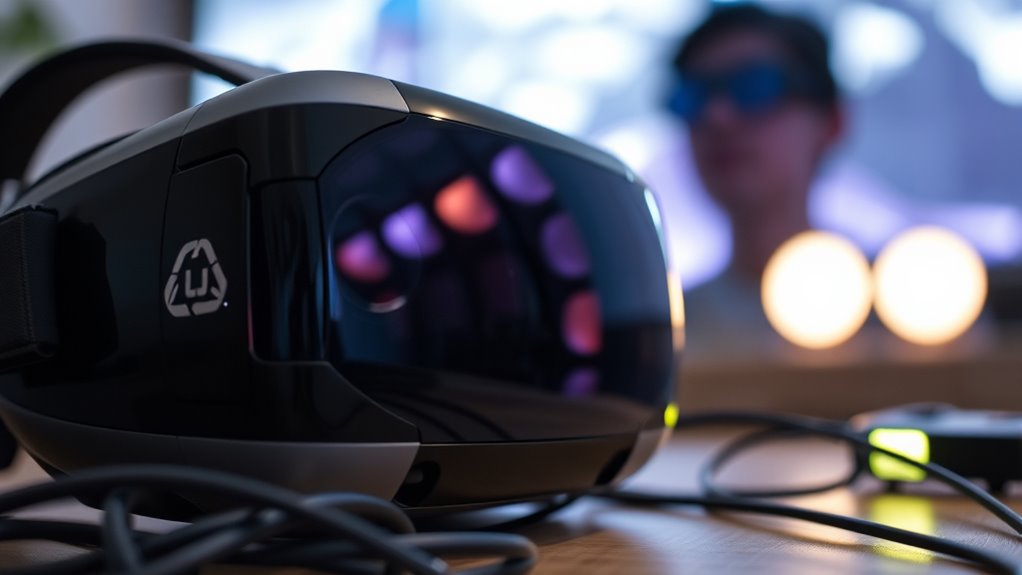A VR headset works by integrating key components like lenses, motion sensors, and advanced display technology to create an immersive experience. The lenses magnify images, while motion tracking translates your physical movements into the virtual world, enhancing your sense of presence. High-resolution displays reduce visual distortions, and spatial audio paired with haptic feedback simulates realistic sensations. Together, these elements transport you to virtual environments, making you feel as if you’re really there. Discover more about its fascinating applications and technology.
The Core Components of a VR Headset
When diving into the domain of virtual reality, understanding the core components of a VR headset is essential. At the heart of your experience lies lenses technology, which magnifies and focuses the images displayed, creating that immersive sensation. The quality of these lenses can greatly impact your visual clarity and comfort. Next, consider the various sensor types integrated into the headset. These sensors, like gyroscopes and accelerometers, track your head movements, allowing you to interact naturally with virtual environments. Each component works together to transport you into a realm where freedom of exploration reigns. Knowing how these elements function not only enhances your appreciation but also empowers you to choose the right headset for your VR adventures.
How Motion Tracking Enhances Immersion
As you immerse yourself in a virtual world, the importance of motion tracking becomes immediately apparent. Motion sensors play an essential role in translating your physical movements into the digital sphere, allowing you to explore and interact with your environment intuitively. This technology enhances your spatial awareness, making you feel like you truly belong in the virtual landscape. When you turn your head or move your body, the headset responds in real-time, creating a seamless experience that keeps you engaged. Without effective motion tracking, the illusion of reality would falter, leaving you feeling disconnected. By capturing even the slightest movements, these sensors elevate your experience, granting you the freedom to navigate, engage, and truly lose yourself in an immersive adventure.
The Role of Display Technology in VR
Motion tracking sets the stage for immersion, but the experience would be incomplete without advanced display technology. The display resolution directly impacts how clearly you perceive the virtual world. Higher resolutions lead to sharper images, making environments more believable and reducing the “screen door” effect that can disrupt your experience. Equally important is the refresh rate, which determines how smoothly these images are rendered. A higher refresh rate guarantees fluid motion, allowing you to look around naturally without lag or stuttering. Together, these elements create a seamless visual experience that enhances your sense of presence in virtual spaces. When both display resolution and refresh rate are optimized, you’ll truly feel like you’re stepping into another reality.
Audio and Haptic Feedback for a Realistic Experience
Immersive experiences in virtual reality rely not just on stunning visuals but also on the power of sound and tactile sensations. Spatial audio plays an essential role, allowing you to hear sounds coming from various directions, creating a sense of presence in the virtual world. This enhances your understanding of the environment, making it feel more real and alive. Coupled with tactile feedback, which provides physical sensations in response to your actions, the experience becomes even more intense. When you interact with objects or face environmental changes, haptic technology simulates touch, helping you feel weight, texture, and impact. Together, spatial audio and tactile feedback elevate your VR experience, granting you the ultimate freedom to explore and engage in a compelling, lifelike manner.
Applications of VR Beyond Gaming
While many people associate virtual reality primarily with gaming, its applications extend far beyond entertainment. One exciting area is virtual tourism, where you can explore breathtaking locations without leaving your home. Imagine wandering the streets of Paris or diving into the Great Barrier Reef, all from your living room. This technology offers a unique sense of freedom, letting you travel the world at your own pace.
Additionally, VR plays an essential role in medical training. Aspiring doctors can practice complex procedures in a risk-free environment, enhancing their skills and confidence. This immersive experience not only prepares them for real-life scenarios but also helps reduce errors in the operating room. By embracing VR, you’re stepping into a future where learning and exploration know no bounds.
Frequently Asked Questions
Can VR Headsets Cause Motion Sickness?
Yes, VR headsets can cause motion sickness. When your eyes perceive movement, but your body feels still, this visual disparity can lead to discomfort. It’s like riding a rollercoaster while firmly planted on the ground—disorienting!
How Do VR Headsets Connect to Devices?
VR headsets connect to devices via wireless technology or cable connections. Wireless options offer freedom of movement, while cables guarantee stable performance. Choose based on your preference for mobility or reliability during your immersive experience.
What Are the Different Types of VR Headsets?
In the domain of virtual adventures, you’ll find mobile headsets offering portability and freedom, while tethered headsets deliver immersive power through direct connections. Each type caters to your unique desires for exploration and experience.
Are There Specific Health Concerns With VR Usage?
Yes, there’re specific health concerns with VR usage. You might experience eye strain or dizziness effects, especially with prolonged use. It’s important to take breaks and stay mindful of your body’s reactions to enhance your experience.
How Long Can I Use a VR Headset Safely?
You can safely use a VR headset for about 30 minutes to an hour, following usage recommendations and duration guidelines. Taking breaks helps prevent discomfort and keeps your experience enjoyable without overwhelming your senses.

